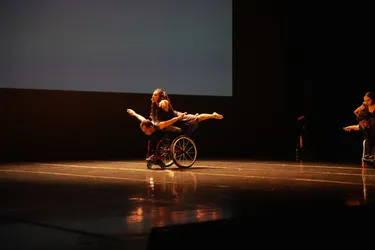“Support Mexican inclusive art,” says Leticia Peñaloza, director of the FUGA dance company, which will give a performance at the Teatro de la Ciudad Esperanza Iris on September 21.
On the stages of FUGA, an independent group celebrating 20 years of experience and recognized by UNESCO as an example of Inclusive Education in Action, dancers with and without disabilities coexist.
“We should no longer talk about dancers with or without disabilities”
Leticia Peñaloza, director of the FUGA dance company
On this occasion, the group formed by about 20 performers will star in Parallel World, a multimedia work that explores the reflection on the coexistence of different worlds.
“It is called parallel because, from the meaning, it is that something goes together but does not touch. That’s the metaphor. When you go on your line and discover another that goes parallel, it is to find another world, because each person has his or her own world; in that sense, it is to keep an eye on another of the worlds with which we coexist,” says its director in an interview with MILENIO.
The montage will be divided into three sections: “One is the approach to blindness, the other to deafness, and the third world to fusion: what happens when we merge, connect as a community, and accept that proposals grow? Creating together detonates many interesting things for everyone”. FUGA celebrates 20 years of stage creation, at a time when talking about inclusion was not so common.
What was it like to create an inclusive project like this?
I got my hands on it. The story was that at the Escuela Nacional de Danza Clásica y Contemporánea Nellie y Gloria Campobello, where I still work, students are trained to be dance teachers and as part of their training they have to teach classes to different groups. At that time they had to give classes in nursing homes and in some special education schools; when I was a consultant, I had to see difficult things, I did an investigation and I saw it as a possibility to work with diversity. I discovered that yes, a thousand possibilities were open, and I made this project develop.
What obstacles have you faced?
They range from the social type to acceptance, and obviously budgets. Not everyone is open to diversity, to differences. There are also access complications in terms of architecture because there is no ramp, and even no Braille books, which accentuates the gap between populations, and does not facilitate coexistence; I think this project is important: it brings people together and proposes ways of working together.
Are we really living in a moment of inclusion?
Not really, in my opinion. There is still a long way to go because inclusion should be a committed philosophy.
For example, if it is an elementary school, the commitment would go from the principal to the parents, and everyone would have to promote it, but segregation continues; the goal I would hope for is that in the not-too-distant future, the question will be asked: how come there were no children in wheelchairs in your elementary school? How come there was no blind person? This coexistence should happen on a daily and normal basis.
On the road to inclusion, we should no longer speak of dancers with or without disabilities, only of dancers. That is the goal of this project and of dance, education, and the arts, but also in society in general. How do you create choreographies when the dancers have different abilities?
It is very interesting because in this company the dancers are also co-creators: they have their own proposals and their knowledge of the body and its possibilities. That’s why we put together duos or trios, what I do is give them some instructions, from which we create the puzzle of the choreography.
Does dance change lives? For me, yes. It changes lives, people, and perspectives; I believe that one discovers other forms of connection, expression, coexistence and that contribute to changing life and transform both the way of appreciating and the way of expressing.
Is the professional training of these artists valued?
We are still in a process because although there have been people with disabilities in dance training schools, in professional schools, there are really very few who have access to training. What we do is an alternative training, but they really should have the same option as anyone else.
They have experience in forums, and they have taken classes with teachers, and with other dancers. Sometimes there is a certain reluctance to pay for a dance show and there is also a preconception that the work of someone with a disability is less valued. However, there are also spaces where their work is valued and recognized.
TYT Newsroom



